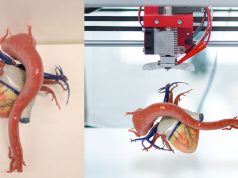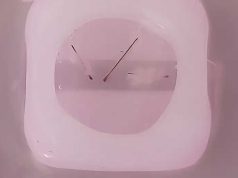A team of researchers from CU Boulder and the University of Pennsylvania has made a major advance in developing life-like materials that can replace and repair human body parts. They have developed a new method of 3D printing that creates materials that are simultaneously resilient enough to withstand the continuous beating of the heart, robust enough to bear the stress of joints, and easily moldable to adapt to a patient’s unique defects.
The newly developed process, which was presented in the journal Science, enables the production of materials that can ideally adapt to the shape and strain of human tissue. These materials are not only strong enough to support the weight of joints, but also elastic enough to withstand the constant movement of the heart. These properties are crucial for applications in the medical field, where flexibility and strength are required simultaneously.
“Cardiac and cartilage tissues are similar in that they have very limited capacity to repair themselves. When they’re damaged, there is no turning back,” said senior author Jason Burdick, a professor of chemical and biological engineering at CU Boulder’s BioFrontiers Institute. “By developing new, more resilient materials to enhance that repair process, we can have a big impact on patients.”
One of the key innovations of the study is the development of a new 3D printing process called CLEAR (Continuous-curing after Light Exposure Aided by Redox initiation). This process enables the creation of molecular structures that behave similarly to interwoven chains, resulting in significantly higher strength and elasticity. This structure is reminiscent of “worm blobs”, in which worms intertwine in a three-dimensional space and exhibit both solid and liquid properties.
The researchers tested the new material in various load scenarios and found it to be significantly more resistant than conventional 3D-printed materials. One notable test involved running over the material with a bicycle without damaging it. The new material also adhered well to animal tissue, underlining its potential suitability for medical applications.
“We can now 3D print adhesive materials that are strong enough to mechanically support tissue,” said co-first author Matt Davidson, a research associate in the Burdick Lab. “We have never been able to do that before.”
In the future, these materials could be used to repair defects in the heart, deliver drugs directly to organs or even support intervertebral discs without damaging the surrounding tissue.
In addition to medical applications, the new method could also have an impact on other areas such as research and manufacturing. The technology requires no additional energy to harden the parts, making the 3D printing process more environmentally friendl
“This is a simple 3D processing method that people could ultimately use in their own academic labs as well as in industry to improve the mechanical properties of materials for a wide variety of applications,” said first author Abhishek Dhand, a researcher in the Burdick Lab and doctoral candidate in the Department of Bioengineering at the University of Pennsylvania. “It solves a big problem for 3D printing.”
In summary, this research shows that 3D printing has the potential to fundamentally change the way materials are made and used in medicine, paving the way for new methods of treatment and repair.
Subscribe to our Newsletter
3DPresso is a weekly newsletter that links to the most exciting global stories from the 3D printing and additive manufacturing industry.






















